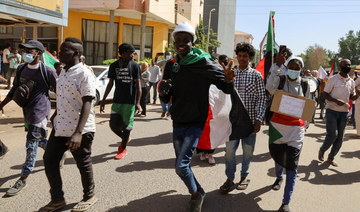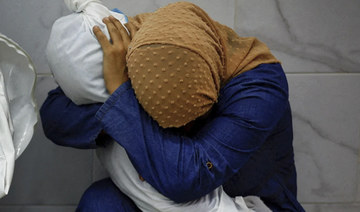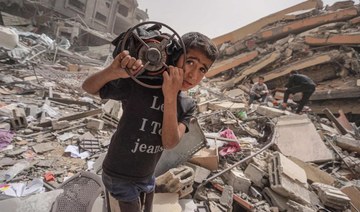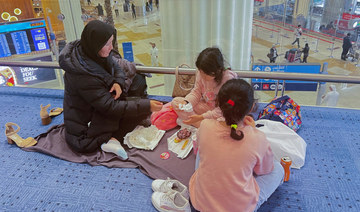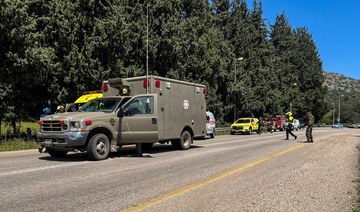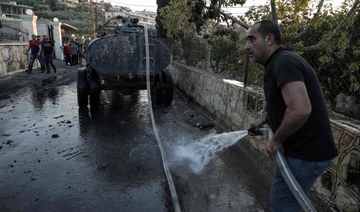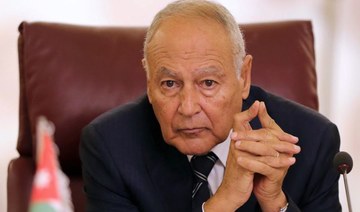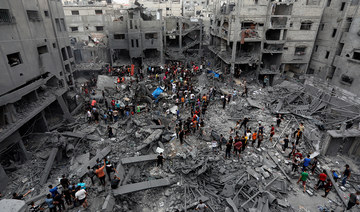CAIRO: Amira Osman, a Sudanese women’s rights activist, was getting ready for bed a few minutes before midnight when about 30 policemen forced their way into her home in Khartoum last month.
The men, many in plainclothes and armed with Kalashnikov rifles, pistols and batons, banged on her bathroom door, ignoring her mother’s pleas to at least allow her to get dressed before they took her away.
“It was like they were engaging in a battle or chasing a dangerous terrorist, not a disabled woman,” said Osman’s sister, Amani, a rights lawyer.
Osman, who uses crutches since a 2017 accident, was imprisoned twice under Sudan’s former autocratic President Omar Al-Bashir for violating strict Islamic laws governing women’s behavior and dress. This time, she was detained for speaking out against military rule.
With her Jan. 22 arrest, Osman joined hundreds of activists and protest leaders targeted since a military coup last October removed a transitional government from power.
The detentions have intensified in recent weeks as Sudan plunged into further turmoil with near-daily street protests, sparking fears of an all-out return to the oppressive tactics of Al-Bashir. The coup upended Sudan’s transition to democratic rule after three decades of international isolation under Al-Bashir, who was removed from power in 2019 after a popular uprising.
“The military delivers one message to international diplomats, that they are interested in a political dialogue and fundamental reform of the state, but then they do nothing to hide their blatant efforts to maintain the status quo and undermine efforts to unseat them,” said Cameron Hudson, a former US State Department official and Sudan expert at the Atlantic Council’s Africa Center.
Following the coup, security forces launched a deadly crackdown on protesters. They fired live ammunition and tear gas at crowds on the streets and knocked the country’s Internet and mobile signal offline — all in efforts to keep people from gathering. Around 80 people, mostly young men, have been killed and over 2,200 others injured in the protests, according to a Sudanese medical group.
Sudanese security forces have also been accused of using sexual violence against women taking part in the demonstrations. The ruling, military-led Sovereign Council said a probe was launched into the allegations of rape and gang rape on Dec. 19, after the United Nations called for an investigation. It is not the first time security forces have been accused of using rape — such attacks occurred under Al-Bashir and also under the military during the transitional period.
The US, UK, and Norway, along with the European Union, Canada and Switzerland, called the recent pattern “troubling,” and urged the release of “all those unjustly detained.”
“We remind Sudan’s military authorities of their obligations to respect the human rights and guarantee the safety of those detained or arrested and the need to ensure that due process is consistently followed in all cases,” the group said in a statement released by the US State Department.
Osman’s detention drew condemnation and concern internationally. She was finally released on Sunday.
But for nearly a week after the arrest, her family didn’t know where she was held. Then, they received a phone call asking them to send clothes to a prison in Khartoum’s twin city, Omdurman, according to her sister, who also is her lawyer.
Osman said she spent the first three days in solitary confinement in “very bad and humiliating conditions.” Then another activist, Eman Mirghani, joined her in the cell. Mirghani remains in detention.
Authorities accused Osman of possession of illegal weapons and ammunition — the “five old bullets” found in her wardrobe, she said, souvenirs from the 2016 national shooting championship in which she competed.
It’s unclear who the officers are who stormed Osman’s house. During the raid, they said they were from a drug-combating force, but Amani Osman, the sister-lawyer, said she believes they were actually from the country’s feared General Intelligence Service.
Formerly known as the National Intelligence and Security Service, the agency was for decades a tool used by Al-Bashir’s government to clamp down on dissent. After the coup, the military reinstated the agency’s powers, which include detaining people without informing their families. They are known to keep many of their detainees in secret prisons called “Ghost Houses.”
Gibreel Hassabu, a lawyer with the Darfur Bar Association, a legal group that focuses on human rights, said the exact number of those detained across the county is still unknown — a situation reminiscent of Al-Bashir’s rule.
Hassabu says he knows of over 200 activists and protest leaders detained in the Sudanese capital alone. Many activists were taken from their homes or snatched from the streets, according to documents he provided to The Associated Press.
At least 46 activists are held in Khartoum’s Souba Prison, the documents show. Some female activists — including Amira Osman — are sent to the women’s prison in Omdurman.
The wave of arrests has expanded following the killing of a senior police officer during a Jan. 13 protest close to the presidential palace in Khartoum. The officer was stabbed to death, according to local media. Security forces raided a Khartoum hospital and arrested six, including an injured protester and women who were visiting him, accusing them of being responsible for the killing.
And on Jan. 29, paramilitary troops from the Rapid Support Forces, another security body with a reputation for brutality, grabbed Mohamed Abdel-Rahman Naqdalla, an activist and physician, from a Khartoum street, his family said.
A spokesman for the RSF did not answer requests for comment. The force is largely comprised of former militiamen and has been implicated in atrocities under Al-Bashir in the the western region of Darfur. It is headed by the country’s second most powerful general, Mohammed Hamdan Dagalo, and runs its own detention centers in Khartoum and elsewhere in the country.
This week, authorities rearrested Khalid Omar, a minister in the ousted transitional government. Omar had been detained in the Oct. 25 coup and was released a month later as part of a deal between the military and civilian leaders. His party, the opposition Sudanese Congress Party, said he was taken Wednesday at the party’s headquarters.
Also arrested Wednesday was Wagdi Saleh, a member of a government-run agency tasked with dismantling the legacy of Al-Bashir’s regime, according to the pro-democracy Forces of Freedom and Change alliance.
The trend has frustrated diplomats working to bring the military and civilian leaders to some sort of an agreement.
“Arbitrary arrests and detention of political figures, civil society activists and journalists undermine efforts to resolve Sudan’s political crisis,” said Lucy Tamlyn, US chargé d’affaires in Sudan.
Sudan’s military rulers step up crackdown, arrest activists
https://arab.news/bs8yg
Sudan’s military rulers step up crackdown, arrest activists
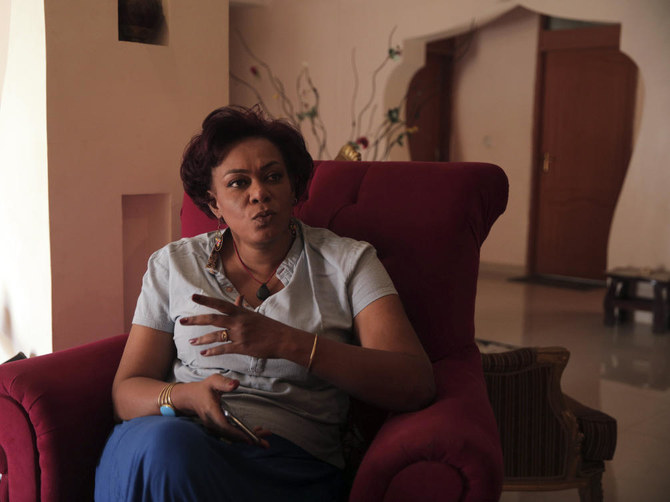
- The detentions have intensified in recent weeks as Sudan plunged into further turmoil with near-daily street protests
- It’s unclear who the officers are who stormed Osman’s house
Gazans search for remains after deadly Rafah strike
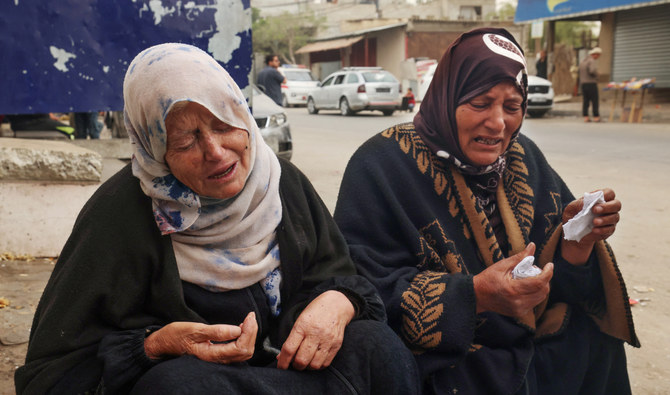
An Israeli strike hit the home where a displaced Palestinian family was sheltering in the southern city of Rafah, relatives and neighbors told AFP as they scraped at the soil with their hands.
Al-Arja said the blast killed at least 10 people.
“We retrieved the remains of children and women, finding arms and feet. They were all torn to pieces.
“This is horrifying. It’s not normal,” he said, hauling concrete and broken olive branches from the wreckage. “The entire world is complicit.”
Soon after the war began on Oct. 7, Israel told Palestinians living in the north of Gaza to move to “safe zones” in the territory’s south, like Rafah.
But Israeli Prime Minister Benjamin Netanyahu has since vowed to invade the city, where around 1.5 million people live in shelters, more than half the territory’s population.
“How is Rafah a safe place?” said Zeyad Ayyad, a relative of the victims. He sighed as he cradled a fragment of the remains.
“I heard the bombing last night and then went back to sleep. I did not think it hit my aunt’s house.”
The search for remains was long and painful. The strike left a huge crater and children picked through the rubble while neighbors removed debris, tarpaulin, a pink top.
“We can see them under the rubble and we’re unable to retrieve them,” Al-Arja said.
“These are people who came from the north because it was said the south is safe.”
“They struck without any warning,” he said.
In a separate strike on the house in Rafah’s Al-Salam neighborhood overnight on Tuesday, rescue crews recovered the corpses of eight family members, including five children and two women, Gaza’s civil defense service said.
“An Israeli rocket hit a house of displaced people,” said resident Sami Nyrab.
“My sister’s son-in-law, her daughter, and her children were having dinner when an Israeli missile demolished their house over their heads.”
Dubai clears up after epic rains swamp glitzy city
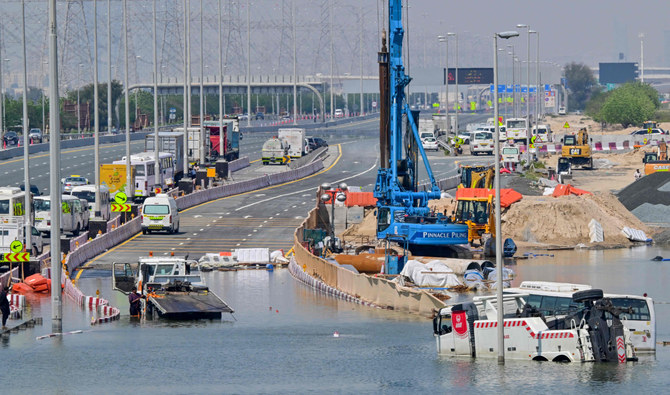
- The rains were the heaviest experienced by the UAE in the 75 years that records have been kept
DUBAI: Dubai was busy on Thursday clearing its waterlogged roads and drying out flooded homes two days after a record storm deposited a year’s worth of rainfall in a day.
Dubai International Airport, a major travel hub, struggled to clear a backlog of flights, and many roads were still flooded in the aftermath of Tuesday’s deluge.
The rains were the heaviest experienced by the UAE in the 75 years that records have been kept.
They brought much of the country to a standstill and caused significant damage.
Flooding trapped residents in traffic, offices, and homes.
Many reported leaks at their homes, while footage circulated on social media showed malls overrun with water pouring from roofs.
Traffic remained heavily disrupted.
A highway through Dubai was reduced to a single lane in one direction, while the main road connecting Dubai with Abu Dhabi was closed in the Abu Dhabi direction.
“This was like nothing else. It was like an alien invasion,” said Jonathan Richards, a Dubai resident from Britain.
“I woke up the other morning to people in kayaks, pet dogs, pet cats, and suitcases outside my house.”
Another resident, Rinku Makhecha, said the rain swamped her newly renovated house, which she moved into two weeks ago.
“My entire living room is just like ... all my furniture is floating right now,” she said.
In Dubai’s streets, some vehicles, including buses, could be seen almost entirely submerged in water.
Long queues formed at petrol stations.
Dubai Airport had not resumed normal operation after the storm flooded taxiways, forcing flight diversions, delays, and cancellations.
Dubai Airport Chief Operating Officer Majed Al Joker told Al Arabiya TV he expected Dubai International Airport to reach 60 to 70 percent capacity by the end of Thursday and full operational capacity within 24 hours.
The airport struggled to get food to stranded passengers, with nearby roads flooded and overcrowding limited access to those who had confirmed bookings.
While some roadways into hard-hit communities remain flooded, delivery services across Dubai, whose residents are used to ordering everything at the click of a mouse, slowly began returning to the streets.
Following Tuesday’s events, questions were raised about whether cloud seeding, a process that the UAE frequently conducts, could have caused the heavy rains.
A UAE government agency overseeing cloud seeding — manipulating clouds to increase rainfall — denied conducting such operations before the storm.
President Sheikh Mohammed bin Zayed Al-Nahyan said in a statement that he had ordered authorities to assess the damage and support families impacted by the storm.
Dubai’s Crown Prince Sheikh Hamdan bin Rashid Al-Maktoum said on X that the safety of citizens, residents, and visitors was the utmost priority.
“At a meeting with government officials in Dubai, we set directives to prepare comprehensive plans in response to natural crises such as the unexpected current weather conditions,” he said.
Hezbollah says 2 fighters killed in Israeli strikes
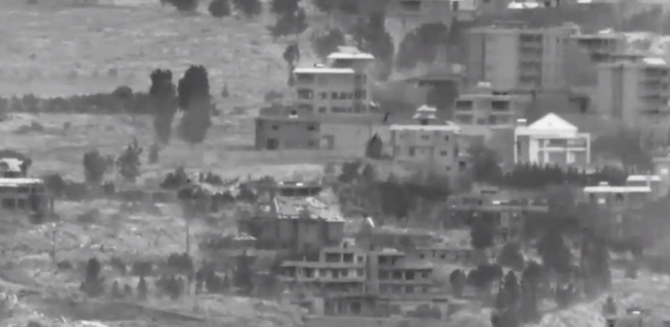
- GPS interference affecting both sides of Lebanese border, source says
BEIRUT: Two Hezbollah fighters were killed on Wednesday as Israel intensified strikes on south Lebanon following an attack by the Iran-backed group that wounded 14 Israeli soldiers.
Israel and Hezbollah have exchanged near-daily cross-border fire since Palestinian militant group Hamas attacked southern Israel on Oct. 7, triggering war in the Gaza Strip.
A security source said: “Hezbollah’s complex attack against the Israeli army in Wadi Al-Aramshe early on Wednesday, which led to the injury of 14 Israeli soldiers, including six with serious injuries, was absorbed by the Israeli side after the painful blow it directed at the party by assassinating three of its field officials.”
The Israeli army responded to the Wadi Al-Aramshe operation on Wednesday night by targeting the town of Iaat in the Bekaa Valley, 5 km from Baalbek. A drone strike hit a warehouse belonging to a member of the Al-Zein family, resulting in light wounds to one civilian.
Israel continues to jam GPS around the Lebanese southern border region, especially during military operations.
A security source said: “This interference negatively affects both the Israeli army and Hezbollah in targeting objectives.”
Hezbollah announced a series of operations since dawn on Thursday, targeting Israeli military sites opposite the Lebanese border.
The group targeted an Israeli force attempting to withdraw a military vehicle that was targeted on Wednesday at Metula, opposite the Lebanese town of Kfarkela.
At dawn, Israeli soldiers in Al-Malikiyah, opposite the Lebanese town of Aitaroun, were targeted by Hezbollah using missiles.
The group also targeted Israeli soldiers in Al-Marj.
“After careful monitoring and anticipation of the enemy’s movement at Al-Marj … they were targeted with missile weapons and suffered a direct hit; some died while others were injured,” the group said in a statement.
Hezbollah attacked Israeli soldiers using missiles in the Hanita forest, opposite the Lebanese town of Alma Al-Shaab.
On Thursday, the party mourned two members killed in Wednesday night’s shelling of Kfarkela. Mohammed Jamil Al-Shami from Kfarkela and Ali Ahmed Hamadeh from Doueir were killed in the Israeli operation.
The Israeli army targeted Lebanese towns with heavy shelling until dawn on Thursday. The town of Khiam was a priority target; correspondents in the area counted seven strikes and 128 artillery and phosphorous shells impacting between 8 p.m. and 4 a.m.
A young man from Habboush, Ahmed Hassan Al-Ahmed, was killed in the shelling and mourned by residents of his town.
Jets struck Hezbollah targets in Khiam, including infrastructure and two military buildings, the Israeli army said.
Israeli drones targeted a house on the outskirts of Markaba and in Blida on Thursday, with casualties reported.
The Israeli army also targeted Kfarkela with two missiles from a drone, and with artillery and phosphorous shells. From Metula opposite the border, Israeli soldiers combed the town with heavy machine guns.
The outskirts of Dhayra, Al-Bustan and Aita Al-Shaab were hit by gunfire from the Israeli position in Birkat Risha and other positions adjacent to the Blue Line.
German airline Lufthansa announced on Thursday it had extended the suspension of flights to Beirut and Tehran until April 30.
The decision was taken on the night of the Iranian attack on Israel last weekend.
UNIFIL spokesman Andrea Tenenti said that the organization’s peacekeepers “remain in their positions and carry out their duties, as well as our civilian staff.”
He added: “The safety and security of UN staff and their families are our priority.”
Dubai clears up after epic rains swamp glitzy desert city
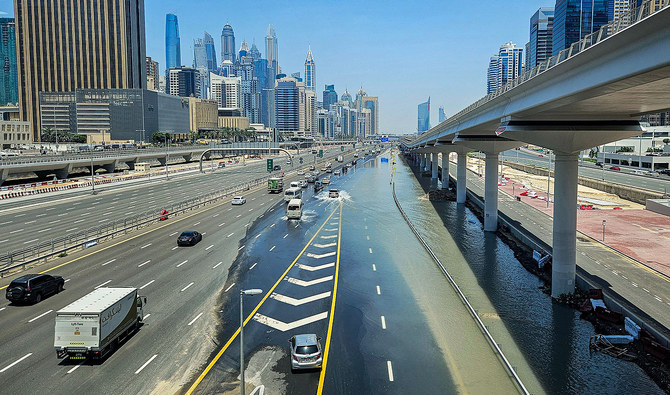
- Rains were the heaviest experienced by the United Arab Emirates in the 75 years that records have been kept
- Flooding trapped residents in traffic, offices and homes, houses’ roofs leaked and malls were overrun with water
DUBAI: Dubai, a city in the desert proud of its futuristic gloss, was on Thursday busy clearing its waterclogged roads and drying out flooded homes two days after a record storm saw a year’s rain fall in a day.
Dubai International Airport, a major travel hub, struggled to clear a backlog of flights and many roads were still flooded in the aftermath of Tuesday’s deluge.
The rains were the heaviest experienced by the United Arab Emirates in the 75 years that records have been kept. They brought much of the country to a standstill and caused significant damage.
Flooding trapped residents in traffic, offices and homes. Many reported leaks at their homes, while footage circulated on social media showed malls overrun with water pouring from roofs.
Traffic remained heavily disrupted. A highway through Dubai was reduced to a single lane in one direction, while the main road that connects Dubai with the capital Abu Dhabi was closed in the Abu Dhabi direction.
“This was like nothing else. It was like an alien invasion,” Jonathan Richards, a Dubai resident from Britain told Reuters.
“I woke up the other morning to people in kayaks with pet dogs, pet cats, suitcases all outside my house.”
Another resident, Rinku Makhecha, said the rain swamped her freshly renovated house she moved into two weeks ago.
“My entire living room is just like ... all my furniture is floating right now,” she said.
In Dubai’s streets, some vehicles, including buses, could be seen almost entirely submerged in water. Long queues formed at petrol stations.
Dubai airport had yet to resume normal operation after the storm flooded taxiways, forcing flight diversions, delays and cancelations.
Dubai Airports Chief Operating Officer Majed Al Joker told Al Arabiya TV he expected Dubai International Airport to reach 60-70 percent capacity by the end of Thursday and full operational capacity within 24 hours.
The airport struggled to get food to stranded passengers with nearby roads flooded and overcrowding limited access to those who had confirmed bookings.
RETURNING SUPPLIES
The storm, which hit neighboring Oman on Sunday, pounded the UAE on Tuesday, with 20 reported dead in Oman and one in the UAE.
While some roadways into hard-hit communities remain flooded, delivery services across Dubai, whose residents are used to ordering everything at the click of a mouse, slowly began returning to the streets.
Rains are rare in the UAE and elsewhere on the Arabian Peninsula, which is typically known for its dry desert climate. Summer air temperatures can soar above 50 degrees Celsius.
Following Tuesday’s events, questions were raised whether cloud seeding, a process that the UAE frequently conducts, could have caused the heavy rains.
But climate experts blame global warming for such extreme weather events.
Researchers anticipate that climate change will lead to heightened temperatures, increased humidity and a greater risk of flooding in parts of the Gulf region. Countries like the UAE where there is a lack of drainage infrastructure to cope with heavy rains can suffer the most.
A UAE government agency that oversees cloud seeding — a process of manipulating clouds to increase rainfall — denied conducting any such operations before the storm.
President Sheikh Mohammed bin Zayed Al Nahyan said in a statement he had ordered authorities to assess the damage and provide support to families impacted by the storm.
Dubai’s Crown Prince Sheikh Hamdan bin Rashid Al Maktoum said on X that the safety of citizens, residents and visitors was the utmost priority.
“At a meeting with government officials in Dubai, we set directives to prepare comprehensive plans in response to natural crises’ such as the unexpected current weather conditions,” he said.
Arab League chief voices Gaza fears in talks with UN official
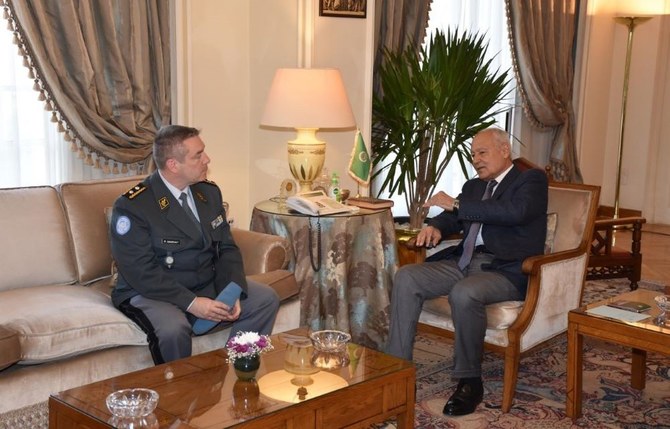
- Secretary-General Ahmed Aboul Gheit met with the UN’s Maj. Gen. Patrick Gauchat
- UNTSO chief briefed the secretary-general on conflicts in several areas monitored by the UN
CAIRO: Arab League Secretary-General Ahmed Aboul Gheit has told a senior UN official that he fears the conflict in Gaza could spiral out control and threaten regional security.
In a meeting in Cairo with Maj. Gen. Patrick Gauchat, head of mission and chief of staff of the UN Truce Supervision Organization, Aboul Gheit highlighted the need to implement the UN Security Council’s ceasefire resolution, and provide urgent humanitarian aid to the famine-stricken population in Gaza.
Gamal Roshdy, a spokesperson for the Arab League chief, said that the meeting discussed the regional situation, with Aboul Gheit saying that Israel’s war on Gaza violated international law and humanitarian principles.
The UNTSO chief briefed the secretary-general on conflicts in several areas monitored by the UN, including the Blue Line, which delineates the truce between Lebanon and Israel.
Aboul Gheit said that political resolutions remain the most effective means to ensure security for all parties.
However, achieving such resolutions remains challenging while Israel pursue its objectives through military force and by targeting civilians, he said.
According to the UNTSO website, the Security Council, in Resolution 50 (1948), called for a cessation of hostilities in Palestine on May 29, 1948, and decided that the UN Mediator should supervise the truce with the assistance of a group of military observers.
The first group of military observers, established in 1949 to supervise the implementation of the Israel-Arab Armistice Agreements, became known as the UN Truce Supervision Organization.
UNTSO observers in the Middle East to monitor ceasefires, supervise armistice agreements, prevent isolated incidents from escalating, and assist other UN peacekeeping operations in the region.



